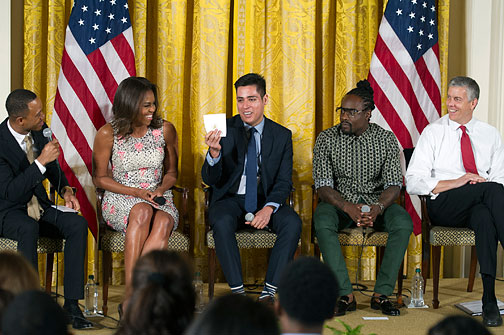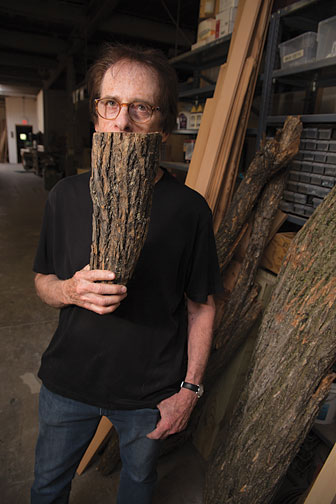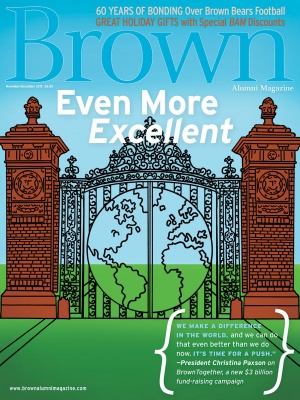Reader comments since the last issue:

First-Gens
I loved “Belonging” and the idea of 1vyG (Elms, September/October.) I felt the same long ago when I attended Brown. My single mom of five had raised us kids on welfare, and I was in awe of Brown and the college experience. But I had to make my way to campus every year by bus and handle financial aid concerns alone. I worried no one would accept me at an Ivy League school.
Manuel Contreras ’16 has a unique perspective and is doing so much for those who deserve a chance in the Ivy League but who do not even know where to start. Even my daughter, a first-year at Brown, is going through an adjustment. Imagine the challenges for students who are dealing with the adjustment by themselves.
In the end I found many wonderful and accepting friends at Brown and loved the experience so much that I stayed for a master’s degree. This acceptance is a key advantage Brown has over the other Ivies.
Congratulations to Manuel on all he has achieved!!
Tracy Kelly Lindsay ’85, ’87 ScM
Comment from brownalumnimagazine.com
As the executive director of First Lady Michelle Obama’s Reach Higher initiative, I was thrilled to invite Manuel Contreras to speak at the White House after meeting with him and hearing his story. I was so proud of how well he articulated the needs of first-gen students, and I’m equally proud of what he and his classmates are doing to bring this issue to the forefront of the national dialogue. Great job, Manuel and Team 1vyG!
Eric Waldo ’00
Comment from brownalumnimagazine.com
Women at Brown
In his letter about his 35th reunion, Larry Kramer ’80 lauds the admirable diversity of Brown’s class of 2015, as evidenced in the Commencement march down College Hill (“Reunion Musings,” Mail Room, September/October). But he erred when he said earlier classes were “wholly male” because Brown “only became coed in 1971.”
In fact, the first female students were admitted to Brown in 1891, and the Corporation approved creation of the Women’s College in Brown University in 1896. In 1928, the name was changed to Pembroke College in Brown University. When I graduated from Brown in 1955, there were 377 men and 170 women (roughly 30 percent) in our graduating class.
Yes, we were called Pembrokers in those days, but the degree was from Brown, and every undergraduate class I took included both men and women. The 1971 date is significant only because that’s when the few remaining separate male and female administrative functions were merged and, as of July 1, 1971, the name Pembroke College in Brown University officially disappeared. In 1991, Brown celebrated the 100th anniversary of women at Brown with a special Opening Convocation and a four-day symposium. Women have been marching down the Hill in those Commencement processions for a long time.
I’m sorry I wasn’t able to join Larry in this year’s march. It was my reunion too. But it’s a very steep hill and my knees aren’t in great shape these days.
Leslie Travis Wendel ’55
Newtown, Pa.
[email protected]

Art the Fishman Way
Professor of Visual Art Richard Fishman changed my life (“The Student-Teacher,” September/October). I became a sculptor when I fell in love with the lab in the basement of List, and even though the first time I held a power tool in my hand I cut off its electrical cord along with the wood, I now am a furniture designer largely because of that experience.
John Strauss ’82
Comment from brownalumnimagazine.com
What is most impressive about Richard Fishman is that he has more energy and enthusiasm than people who are one-third his age. Clearly, he has many years of creative energy to go, and his talent is a rare gift that he should continue to share. I am not an artist, but Fishman’s extraordinary output and contribution make me wish I had half his talent. He continues to be an inspiration to Brown students and faculty on every level.
Robert Raiff ’79
Comment from brownalumnimagazine.com
I had a chance to work closely with Richard Fishman as an inaugural member of Brown’s Creative Arts Advisory Board. His vision, leadership, and energy are unmatched, and Brown is immeasurably richer for his contributions. He’s a treasure!
Russ Pillar ’87
Comment from brownalumnimagazine.com
I took a studio art painting course with Richard Fishman my freshman year. He submitted two of my early paintings to an art contest and exhibit at RISD. One day I was walking down to the art department when several classmates shouted “Congratulations!” Unbeknown to me, I had won first prize! Now my home in Washington, D.C., is filled with my paintings, and I get great joy from them every day. Thank you, Prof. Fishman!
Rita Chao Hadden ’69
Comment from brownalumnimagazine.com
Computers and Teachers
When I took Andy van Dam’s first class in the fall of 1965, the Computer Lab housed an IBM 7070 mainframe and an IBM 1401 peripheral controller (“The Mentor,” September/October). The 1401 was meant to relieve the mainframe of slow, boring card reading, paper-tape punching, and printing so it could use its enormous processing power on important number-crunching. To give some idea of the speed of this monster, the number of machine instructions that your smartphone does in one second would have taken the 7070 about three months. It cost $6 million in today’s dollars.
Bob Munck ’67
Comment from brownalumnimagazine.com
A couple of dates are a bit confused here. Yes, the applied math department did house an IBM 650 in 1965 (I was introduced to it as an applied math sophomore in 1958), but the IBM 7070 arrived long before 1965.
How do I know? I was employed by the computer lab as a machine operator (among other duties) for the year after I graduated (1961–62). This was before there was such a thing as an “operating system,” and the 7070 had to be booted up from a large tray of punched cards every morning: be very careful never to drop them!
As a side note, I think I was the only person at the lab who actually liked the rug that appears over Professor Andy van Dam’s head in the photo of him that appears with the article. I still enjoy looking in through the glass doors of the lab and seeing it (now rather faded) when I pass by that building.
Barbara Neuhaus Beeton ’61
Comment from brownalumnimagazine.com
That’s no rug; it’s a tapestry. Designed by painter Arshile Gorki, it was a gift from Philip Johnson, who was the architect for the computer lab. —Editor
From Brown to West Point
I would like to add my voice to those of other alumni who in the past two issues have advocated for the return of ROTC to Brown (“ROTC Debate,” Mail Room, September/October).
While I have followed this issue closely over the years, I have hesitated to write due to my somewhat unique background: I was a (proud) member of Brown’s class of 1967; however, I left after freshman year to enroll at West Point. After President Kennedy’s assassination in 1963, I felt I needed to serve my country more directly. I stayed on active duty, spent two combat tours in Vietnam, taught leadership at West Point, and then transferred to the reserves, retiring as a colonel.
After a long business career, I am now an adjunct professor teaching leadership and management at several New England colleges, including Boston University and Babson College. At every school where I’ve taught, students have been avidly interested in the lessons of military service. The values of self-sacrifice, discipline, sense of duty, and love of country resonate with them as they begin to find their own paths. They recognize the important and critical role that service, broadly defined, can play in their own growth and development, and they value interacting with those who have experienced situations that required leadership under pressure.
In addition to the reasons so well articulated by the other alumni, I would add one more. Many Brown students will graduate to nonprofit or government service. At some point, they will need to interact with members of the military. Would it not make sense, as it has historically, to begin the process of mutual understanding on Brown’s campus? Brown’s ethos of critical thinking, it seems to me, would be more than enhanced by this kind of exposure and would better comport to the classical definition of a university.
If memory serves me correctly, there are several monuments on Brown’s campus to alumni who chose to join the military. If they could speak, which side of this issue do you think they would be on?
William A. Bachman ’67
Natick, Mass.
Understanding Muslims
I enjoyed “A Dazzling Voice” in the September/October issue. Lawrence Goodman brought Muslim American Ayad Akhtar ’93 to life for BAM readers. Being a spokesman for the Muslim immigrant experience is an unplanned role for Akhtar. He would rather be an actor and playwright. He succeeds quite well, however, in his unwanted public relations role.
Such public relations are needed. Most Americans and most Muslims do not understand each other. The Capital Area Interfaith Alliance (CAIA) is trying to do something about this. We recently brought in Rihab Sawah, a Syrian American woman, to talk about Islam vs. Islamic State. She was born in the United States and raised in Syria. She teaches both physics and theology. We first learned about her through her radio show, Arab Music Arab Culture. I congratulate the BAM for working toward goals similar to those of CAIA and for bringing people together.
Frank Rycyk ’66
Jefferson City, Mo.
Your article on Ayad Akhtar surpassed even BAM’s usual standard of sycophancy when it claims Akhtar will not say what he thinks about 9/11 because it would prejudice audiences and reveal his politics. On the contrary, if true, an unwillingness to condemn the mass murder of thousands of fellow Americans speaks volumes about his politics and humanity.
Brad Stone ’79
Darnestown, Md.
I really appreciate receiving the BAM. The article on Ayad Akhtar is so relevant to issues of racism and diversity in our world today. Keep up the good work.
R. Brayton Bowen ’62, ’65 AM
Comment from brownalumnimagazine.com
Animal Cruelty
I was disappointed to read, in the September/October issue’s “Summer Stories,” that one student’s summer activities included killing a pigeon and making a video of it (Elms).
I guess it’s not so surprising that this student, who is clearly immature, would do such a thing and then brag about it. However, most people believe that cruelty to animals is morally and ethically wrong, whether the animal is of the cute, cuddly variety or a less lovable pigeon or squirrel.
I imagine the other students discussed in the article were not happy that their generous summer activities—volunteering, teaching, doing research, interning—were mentioned alongside an example of animal cruelty. The BAM should not have given this student’s activity, which you called a “bizarre accomplishment,” the privilege of being publicized.
Daniel Lamoureux ’66
Boston
The Veteran's College
Marjorie Greene Hazeltine-Wolfe ’44 describes her job in University Hall working for James Cunningham and Vernon Alden ’55 (Classes, September/October). To expand on Ms. Hazeltine-Wolfe’s recollection, Cunningham was the director of the Veterans College, and Alden was assistant director. Ron Wilson ’50 has written an excellent paper describing the advent of the Veterans College in 1946 to provide returning World War II veterans with access to a Brown education. Ron’s description of the Veterans College is on the class of 1950 website.
Paul D. Lipsitt ’50
Newtonville, Mass.
Don't Blame the Drillers
I expected more from the BAM in its profile of John Barry ’68 (“The Passionate Historian,” July/August). I am a geological sciences PhD from Brown and a former director of energy for the Geological Survey of Canada, one of the top three surveys in the world. I actively consult in the petroleum industry and participate in many community outreach sessions focused on climate change, fracking, and other environmental issues.
What bothered me is the bias in the article. The Louisiana plan to rebuild its coastal wetlands is a morally disingenuous effort to find money other than through taxation “to fund the state’s rebuilding of its vanishing coast or to build higher levees” by throwing blame at the petroleum industry. It is also an unethical effort by the lawyers to line their own pockets by making money off the backs of an industry valuable to the state’s economy.
The industry has admitted to contributing to damage affecting the wetlands. They should be held responsible for any damage they do. In Canada such damage has to be repaired right away, but in North America we have evolved only in the last couple of decades to truly enforcing regulations. Many jurisdictions do not do and have not done a good job of regulating, mainly because they lack resources.
Before blaming the petroleum industry, the state should be laying the blame at the feet of earlier officials and the U.S. Army Corps of Engineers, whose goal, as you note, was “to tame the lower Mississippi.” The loss of the wetlands is first and foremost the result of the creation and maintenance of the huge levees that permit shipping traffic to move up the Mississippi. A delta requires the sediment load from flooding into the wetlands, which lie between the channel areas, to maintain itself. Once deposited, the sediment compacts, resulting in subsidence, which can only be counteracted by the addition of new sediment to maintain the wetlands. Upriver the Mississippi has breached its levees ever since the river has existed and has flooded the adjacent prairie, thereby refertilizing those lands. It is what rivers do.
As long as we avoid the full stories, we are going to repeat errors that lead to bad decisions with tremendous costs. Education is more than blurting out biased thoughts. We must continue to ensure that people become knowledgeable about a subject before they begin professing to know. I thought that was what Brown offered to all its students.
John D. Harper ’69 PhD
[email protected]
Calgary, Alberta, Canada
Like us on Facebook and follow us on Twitter.





